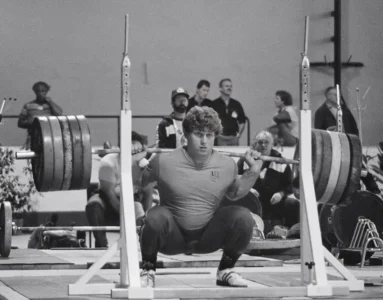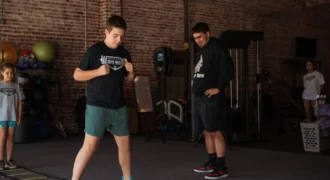Think twice before adding this popular exercise to your program.
Introduction
Strength coaches regularly explore new exercises, training methods, and innovative technologies to gain a competitive edge. An example of this mindset is the focus on the Romanian deadlift. While the exercise is an effective muscle builder, it may not live up to its hype for improving athletic performance.
I want to present the position that the Romanian deadlift (RDL) may not be superior to the exercises it replaces. I will also offer the moderately outrageous opinion that if an athlete’s sport requires explosiveness, the RDL may do more harm than good. But first, let’s explore how we got here.
I will also offer the moderately outrageous opinion that if an athlete’s sport requires explosiveness, the RDL may do more harm than good, says Kim Goss
Share on X
Dawn of the Romanian Deadlift
Romanian weightlifter Nicu Vlad won gold at the 1984 Olympics and set a world record in the snatch with 442 pounds while weighing 220 pounds. In 1990, during a weightlifting clinic at the Sports Palace Gym in San Francisco, Vlad was seen performing a unique deadlift, working up to 550 pounds for three reps.
Someone asked what the exercise was called, but Vlad and his coach, Olympian Dragomir Cioroslan, said they didn’t have a name for it. Sports Palace owner Jim Schmitz, one of America’s most accomplished weightlifting coaches, suggested calling it the Romanian deadlift. The name stuck. (Fun fact: Schmitz said that Yoshinobu Miyake, a Japanese weightlifter who won gold in the 1964 and 1968 Olympics, attended this clinic. He claimed to have performed the exercise in the 1960s. Had the Internet been around in the 60s, the exercise could have been called the Japanese deadlift or, even better, the Mr. Miyake deadlift!)
Although Vlad and Miyake performed the exercise, it doesn’t necessarily mean that other Romanian weightlifters or weightlifters in other countries used it. The late sports scientist Bud Charniga attended numerous European and World Weightlifting Championships and visited many national training centers. In 2007, I asked Charniga about the exercise, and he said that he rarely saw anyone “doing anything that resembles a Romanian deadlift.”
What can also be concluded from Charniga’s observations is that champions often succeed despite their unique training methods, not because of them. Let’s take an example from boxing.
Floyd Mayweather, Jr., who finished his career with a 53-0-1 record, often performed shadow boxing with light dumbbells. Moritz Klatten, a German strength and conditioning coach who has worked with three Olympic champions and five professional world champions, believes this is a bad idea.
“Due to a physics principle commonly referred to as Newton’s Second Law of Motion, the dumbbells increase the momentum of the arms and therefore force the joints beyond their range of motion,” says Klatten. “The fad faded away as people discovered that this ballistic exercise caused overuse injuries in their shoulders and elbows.” Klatten adds that the exercise can “adversely affect the fine-movement patterns of a boxer’s punches.”
What can also be concluded from Charniga’s observations is that champions often succeed despite their unique training methods, not because of them, says Kim Goss
Share on X

Image 1: Nicu Vlad is a Romanian weightlifter who popularized the Romanian deadlift. (Bruce Klemens photos)
The Devil is in the Details
One of the major differences between a Romanian deadlift and a conventional deadlift is that the Romanian deadlift is performed from the top down. This means that, unlike a conventional deadlift, many of the targeted muscles of the posterior chain are stretched before they are shortened.
One advantage of this top-down sequence is that if you can’t reverse the motion and are forced to lower the weight to the floor, you still work the targeted muscles throughout the full range of motion of the exercise (via an eccentric contraction). With a conventional deadlift, if the weight is too heavy, you might not be able to move it at all, providing only an isometric contraction at the start position.
It’s also important to note that the RDL differs from a straight-leg deadlift in that the knees slightly bend during the exercise. I was the editor of Bigger Faster Stronger magazine for a decade. During their clinics, BFS coaches promoted the straight-leg deadlift while standing on a bar to increase the range of motion. With the BFS version, the exercise begins with the back arched but is allowed to flex at the finish—you could say it resembles a physical fitness sit-and-reach test, but from a standing position.
According to the company’s founder, Dr. Greg Shepard, the straight-leg deadlift “should not be used as a strengthening exercise by being performed with heavy weights. Instead, it should be thought of as a stretching exercise.” In fact, for junior high school boys and girls, Shepard recommended using just 45 pounds or less. (Note, a competition women’s Olympic barbell is 33 pounds, and many exercise equipment companies offer even lighter Olympic bars.)

Image 2: The midpoint of the Romanian deadlift (left) and the full stretch position of the straight-leg deadlift while standing on a box. (Right image courtesy BFS; drawings by Sylvain Lemaire, Hexfit.com)
Hard “Core” Training
Before RDLs, one of the go-to exercises for the posterior chain muscles for Iron Game athletes was the good morning. And no discussion about this exercise would be complete without mentioning Bruce Randall.
On January 3, 1953, Randall weighed 203 pounds at 6-2. By August 2, 1955, he had bulked up to 401 pounds and was routinely doing reps with 400 pounds in the good morning; he reportedly hit a max of 685 pounds. When Randall decided to lose weight, he followed a strict low-calorie diet that helped him shed 218 pounds in 32 weeks. In 1959, he won the NABBA Mr. Universe. As such, it can be said that during his era, Randall earned the title, “The Biggest Loser!”
In powerlifting, Louie Simmons of the Westside Barbell Club promoted the use of heavy good mornings with maximal and near-maximal weights to improve performance in the squat and deadlift. The Westside Barbell Club produced more 900-pound squatters and deadlifters than any other club, so the emphasis on this exercise was justified. However, most weightlifters practiced the good morning exercise differently than powerlifters, especially after the Olympic press was eliminated from competition after the 1972 Olympics.
Until 1964, during a weightlifting competition, the barbell was not allowed to touch the lifter’s thighs during the pull. This meant that the shoulders had to stay well in front of the barbell, which required exceptional strength in the lower back (erector spinae muscles). Weightlifters favored the good morning exercise to build strength in these muscles, particularly because it was performed from a standing position, unlike back extensions. (Now, not only do weightlifters brush their thighs, but with the technique often used by Chinese female lifters, the shoulders do not extend in front of the knees, reducing the stress on the lower back.) Also, because weightlifters performed high-bar back squats, they were comfortable holding the bar on their shoulders to perform good mornings.
Next, until the 1972 Olympics, athletes competed in the Olympic press. This lift required exceptional strength in the abdominal and lower back muscles. Image 3 shows American lifters Dan Cantore and Gary Deal in key torso positions (start and midpoint) of the Olympic press. Both lifters set American records.

Image 3: American lifters Dan Cantore (left) and Gary Deal (right) perform the Olympic press, which requires exceptional core strength. (Bruce Klemens photos)
After the 1972 Olympics, many auxiliary exercises were removed from the training routines of most weightlifters because the Olympic press was dropped from competition. The Bulgarian lifters specifically concentrated on the classical lifts and the squat. Such specialization enabled them to become a weightlifting powerhouse for over two decades, with their national coach Ivan Abadjiev producing 12 Olympic champions and 57 world champions.
Weightlifters who continued using the good morning generally performed the upward (concentric) portion of the movement explosively and with relatively lighter weights. According to Charniga, good mornings were typically performed at the end of a workout, using 50 to 55 percent of a lifter’s best snatch for 3-4 sets of 4-8 reps.
The same training approach applies to squats, as many elite lifters avoid squats with maximum single attempts, preferring to perform the lift more explosively and for several repetitions. I believe it was legendary weightlifting coach Joe Mills who said, “Slow grinding squats make for slow grinding cleans.”

Image 4: The positions of a weightlifter performing the barbell good morning resemble the mid-pull position of a weightlifter performing the snatch. (Left photo by Bruce Klemens; right photo by Joseph McCray, LiftingLife.com)
It should be noted that there are different types of good mornings, such as those used to dynamically stretch the lower back muscles. A conventional good morning is performed with a neutral spine, which involves a slight arch in the lower back. This keeps the erector spinae muscles in an isometric contraction. Some argue, however, that rounded back exercises with light weights can also serve as a form of dynamic stretching. Why should we care?
During many basic athletic fitness exercises, such as squats and power cleans, the lower back is arched through the entire exercise. According to weightlifting legend Tommy Kono, this posture creates chronic tension in the lumbar muscles that adversely impacts “the explosive contractile quality of the muscle of the lower back.”
To relax these muscles, Kono promoted a rounded back deadlift that he called the “loosening deadlift.” The exercise begins like a straight-leg deadlift, but rather than hinging at the hips, the individual slowly uncurls (i.e., flexes) their spine from the top down as they lower the bar. Image 5 shows three other variations of this exercise I’ve used with my athletes, performed with a weight plate. I would caution coaches, however, that those with disc issues or other back problems could aggravate their condition with these movements.
With that history lesson, let’s move on to the pros and cons of the RDL.

Image 5: Three variations of rounded back good mornings that help reduce tension in the lower back. (Drawings by Sylvain Lemaire, Hexfit.com)
The Case Against the Romanian Deadlift
According to Charniga, one of the significant issues with the RDL is that it trains the athlete to move the trunk in isolation from their legs. “In weightlifting, you’re trying to use your legs throughout the whole movement, rather than passively using your legs as is done during a Romanian deadlift. This exercise has nowhere near the coordination structure of a snatch or clean, and as such, I would strongly discourage any lifter from performing it.” There’s more.
“The Romanian deadlift is trying to simulate Olympic lifting, but the fact is it’s only a fraction of a second that your hip extensors are on their own during a pull,” says Charniga. “In other words, when you reach a point where you lift a weight to above knee level in the snatch or the clean, there’s an instant where your legs are almost straight and your back is pretty much on its own. At this point, your knees automatically shift forward so that your legs and your trunk together can straighten your body. In a Romanian deadlift, you’re doing something where you’re moving your trunk in isolation– your legs stay still – and as a result, it has a negative transfer to the pull.”
Next, I’ve recently discussed the RDL with Charniga’s colleague, Todd Lyons, a former elite weightlifter. He says that an important factor to consider when talking about which exercises will help with the classical lifts is “reflex latency,” defined as the time between when a stimulus is applied and the start of a reflex response.
Lyons states that during a snatch or clean and jerk, lifting maximal loads requires movement velocities that approach the limits of reflex latency, leaving no opportunity for conscious motor planning during execution.
Video 1 shows my athlete, Christian Rivera, performing a snatch with about 1.55 times over his bodyweight and a clean and jerk over double bodyweight. You’ll see that the pull after the bar separates from the platform is performed too quickly for an athlete to consciously consider each point of the movement. As a result, the neuromuscular system must rely on motor engrams and reflex arcs to perform these explosive movements efficiently.
Video 1: Weightlifter Christian Rivera weighed 143 pounds in this competition, where he broke New England records. Here he snatches 222 pounds and clean and jerks 288 pounds (double bodyweight!).
One argument against using RDLs for weightlifters is that many elite weightlifters perform pulls from the floor. However, consider that using maximal weights in pulls can negatively impact a weightlifter’s technique and explosiveness. Notes Soviet sports scientist Alexey Sidorovich Medvedev, “A significant number of lifts with limit weights in pulls does not promote the perfection of the so-called ‘explosive-strength,’ and at the same time leads to significant deviations from the optimal technique characteristics.”
Expanding on Medvedev’s comments, Charniga explained that explosive athletes, such as weightlifters and sprinters, must rapidly switch between powerful muscle contractions and relaxations within the same muscle, as well as minimize the overlap between agonist and antagonist muscle contractions. In other words, to be fast, you must train fast! Let’s look at an experiment to demonstrate this concept.
Perform a few sets of light, conventional barbell curls as a warm-up. Then, place the barbell under the safety pins in a power rack, set at the mid-range position of a biceps curl. Perform a maximal isometric contraction for about 15 seconds, pulling as hard as you can. Do two more sets, put down the bar, then try to flex and extend your arms as quickly as possible. The result?
You’ll find that the extreme mechanical tension on the biceps for a prolonged period induces muscle stiffness due to a delay in the relaxation process, a byproduct of prolonged electrochemical mechanisms. This inability to relax the muscle quickly directly affects the speed at which your arms can flex and extend.
Lyons explains that extended isometric and near-isometric contractions can “reprogram the nervous system,” making it challenging for muscles to transition rapidly from maximum tension to maximum relaxation. Further, studies have compared the sprinting and jumping ability of powerlifters and weightlifters. While powerlifters can lift heavier weights in squats, weightlifters often outperform them in jumps and short sprints due to their superior ability to switch quickly between muscle contraction and relaxation.

Image 6: Lifting maximum weights in squats and deadlifts slowly increases strength but is not the best method for enhancing sprinting and jumping ability. (Left two drawings from Bruce Klemens’ photos; right photo by Karim Ghonem.)
The takeaway is that slow, partial-range exercises fail to develop the high-velocity, full-range coordination necessary for efficient force transfer. Only consistent practice of the complete lifts can ingrain the reflex-like motor patterns essential for technical mastery and peak performance. As such, I believe one reason many sprint coaches do not experience much success with weight training programs is that they use exercises and training protocols more suitable for bodybuilders, powerlifters, and strongman athletes.
There is no question that the Romanian deadlift can generate a high level of mechanical tension to increase strength in the posterior chain muscles. However, maintaining high muscle tension for long periods is not compatible with running faster, jumping higher, and becoming a more powerful athlete.
Maintaining high muscle tension for long periods is not compatible with running faster, jumping higher, and becoming a more powerful athlete, says Kim Goss
Share on X
References
Schmitz, Jim. “RDL: Where It Came From, How to Do It.” Milo, ND.
Charniga, Bud. Personal Communication, December 10, 2007.
Klatten, Moritz. The Klatten Power Boxing System, pp. 27-28. Champ Performance, April 1, 2016.
Goss, Kim. “BFS Position Paper: Straight-Leg Deadlift.” BFS, July/August 2010, pp. 20-22.
Roach, Roach. “The Amazing Transformation of Bruce Randall.” Iron Game History, 2008;10(3) (Reprinted from Muscle, Smoke & Mirrors; House Publishing, 2008).
Charniga, A., Jr. “Variations and Rational Use of the Good Morning Exercise.” NSCA Journal. 1986;8(1): pp. 74-77.
Kono, Tommy. “The Loosening Deadlift.” Strength and Health, 1974.
Lyons, Todd. Personal Communication, October 15, 2025.
Medvedev, Alexey Sidorovich, et al. “A Comparative Analysis of Clean Technique and Clean Pulls with Various Weights.” 1981 Weightlifting Yearbook, pp. 61-64. Sportivny Press, 1981.
The post Reconsider the Romanian Deadlift appeared first on SimpliFaster.







